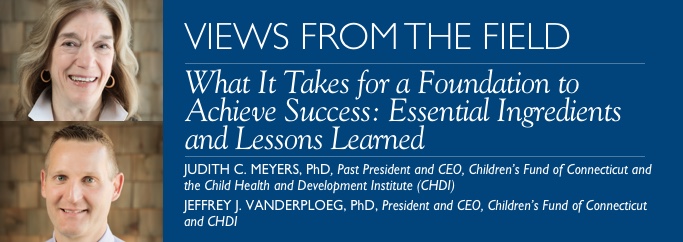
Create healthy outcomes through lasting systems change for children in the state of Connecticut. This was the charge to the Children’s Fund of Connecticut when it was created 25 years ago as a public charitable foundation. Several years after its creation, the fund operationalized this charge by establishing the Child Health and Development Institute (CHDI), its non-profit subsidiary. Together, the organizations have advanced effective policies, stronger systems, and innovative practices in primary and preventive pediatric health and mental health care.
This past year, Judith Meyers, long-time President and CEO of both organizations, transitioned leadership to Jeffrey Vanderploeg who had held increasingly senior positions at CHDI over ten years. As part of a collaborative year-long transition process, we reflected on the successes and lessons learned in leading CFC and CHDI (the full report is available at https://www.chdi.org/twenty-years ). We have identified five basic premises as essential to this work and nine lessons learned. We share these insights in the hope that they may help others achieve success and avoid some of the pitfalls we experienced along the way.
Key Components of Our Success
- Being Mission-Driven. Our core mission has remained constant, focusing on improving Connecticut’s health and mental health care systems through policy, systems, and practice change. Although the work broadened and deepened over time, we stayed true to our identity and purpose, recognizing that systems change is a complex and lengthy process. Cultivating a board that has been supportive of the long-term nature of achieving sustainable reforms has been key.
- Work that is Knowledge-Based. We rely on scientific research and practice-based evidence to shape our work, without being driven by ideology or partisanship. As a result, many groups working to shape policy and systems and to change practice recognize our organizations to be a trusted, independent voice.
- Our Unique Structure. The partnership between the foundation and an operating entity has served us well. CFC has provided core funding that has given CHDI the ability to leverage these dollars many times over (close to a 1:6 ratio). By bringing money to the table, we forged funding partnerships to multiply our effects and CHDI was able to remain free of many of the constraints found in the larger bureaucracies of academia and government agencies, giving CHDI maximum flexibility, nimbleness, and responsiveness to the changing policy landscape. Although this structure is somewhat unique, many foundations go far beyond traditional grantmaking, incorporating similar activities as those under CHDI’s umbrella as part of their portfolio.
- Strategic Partnerships. Partnering with organizations and individuals has been vital to our success. We have worked with more than 100 national, state, and local organizations and individual consultants over the years including academic, provider, government, advocacy, and other organizations. This has allowed CFC, a relatively small foundation, to enhance its influence through contributing to and leveraging resources of others.
- Investment in Communications. As we grew in terms of external funding, staff, and programmatic activities, we recognized the role of communications in advancing our work. For many years board members and others referred to us as “Connecticut’s best kept secret.” Making our work more visible and the impacts more tangible and accessible allowed us to engage a wider range of influencers and partners capable of helping us achieve lasting results.
Lessons Learned
- Systems, policy, and practice are intertwined. Too many innovative and effective practices disappear once a grant funding cycle ends. To advance sustainable practice reform, we found it to be essential to simultaneously work on policy and systems change. Providers cannot be expected to change their practice if they do not have policy and system supports that enable them to adopt and sustain changes.
- Avoid mission creep. Every five years or so we reassessed the alignment of our work with our mission. At such times, working with our board, we clarified our boundaries and set criteria for what to take on and, just as important, what to let go. A long-term, mission-driven agenda helped us to stay the course. We were less effective when spread too thin.
- Assessing impact is difficult but vital. Developing metrics to better document the difference made in key initiatives was vital to our success in advancing sustainable change. Although this was one of our more difficult challenges, we increasingly appreciated the importance of doing so, not only as a means of accountability to our board, but to be able to track our progress and determine the effectiveness of our work.
- Anticipate change. Change is a constant when working in the policy environment. There will always be ups and downs in the economy, changes in political leadership and key players in the executive and legislative branches, and unanticipated crises. By learning to anticipate these likelihoods and be poised to respond to the opportunities these situations presented, we were able to weather these occurrences by being nimble and flexible. Our ability to maintain a long-term focus also helped yield “ready-to go” resources when a need or opportunity arose.
- Cultural competence is an important core value that is critical to success. Cultural, linguistic, and racial/ethnic competency became increasingly core to our work as the data indicated inequities in the system that could not nor should not be ignored. We developed and implemented a cultural competency plan beginning in 2008 that is regularly monitored and revised by a standing Cultural Competency and Workplace Climate Committee that addresses both internal organizational concerns as well as the external work we do. We have regular trainings, have built this competency into performance reviews, and assess and support staff on their progress.
- Families play a crucial role. Recognizing that family advocacy organizations play an important role in advocating for and implementing policy and systems change, we provided funding for, and worked closely with, a number of such organizations. We helped incubate two family organizations to become independent entities and provided grant support and technical assistance to several others in the early childhood, mental health, and juvenile justice arenas.
- Investing in and maintaining a healthy organizational culture and climate is fundamental. We intentionally invested in building a purpose-driven and supportive work environment. This was easier when our staff was small but as we grew to more than 30 employees it became even more important. The first step was hiring great people who fit with our system-level focus and then doing everything possible to support them in their work so that they stayed. We established a ”culture of excellence” by setting high expectations for the quality of our work, providing consistent supervision and performance reviews, rewarding good work, and engaging all staff in planning and implementing a team-oriented workplace.
- Being at the table is a worthwhile investment of time and resources. The participation of staff in as many as 40 to 50 national, state and local committees, commissions, and councils in any given year has been key to accomplishing our goals. Although time consuming, our presence has helped create long-term relationships and myriad opportunities to inform, advise, and influence policies and practice that advanced effective community-based child health systems. This was evident in such results as health and socio-emotional development being included in state and local school readiness efforts; advancing trauma-informed, evidence-based mental health practices for children; influencing juvenile justice reform efforts; and embedding prevention and early identification in health care practice in the state’s health reform agenda.
- Thoughtful succession planning. The transition from a founding director to new leadership after many years can be challenging and is often avoided by many organizations. By anticipating the eventual change through a clear succession plan, identifying and cultivating leadership within the organization over several years, and working with the Board, staff and key partners, we were able to prepare for, support, and sustain a smooth transition.

